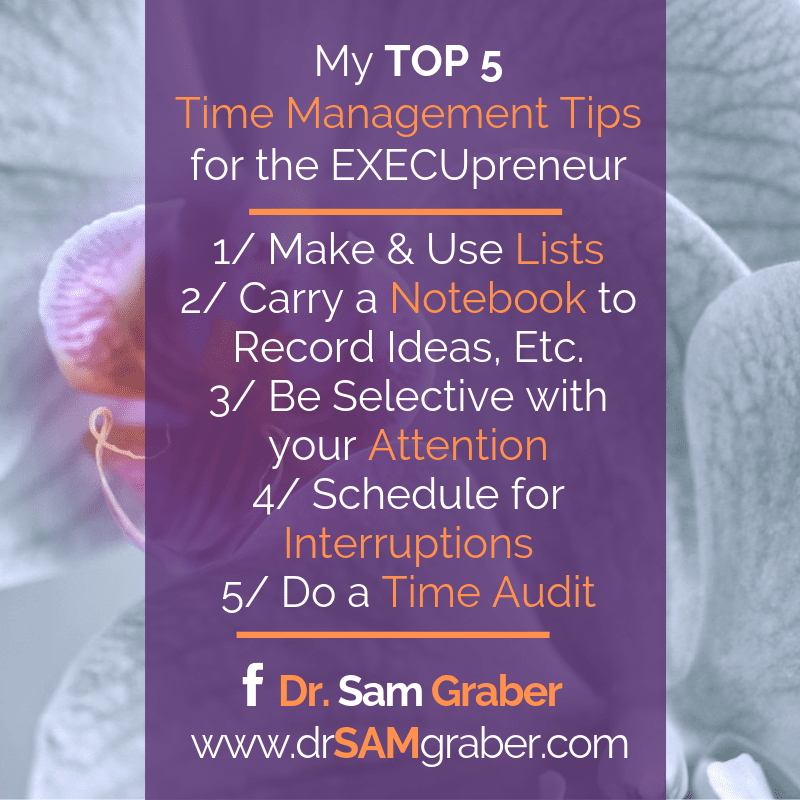
EE 041: 5 Time Management Tips for EXECUpreneurial Success
To be a successful EXECUpreneur, it is essential that you are able to manage your time to accomplish as many tasks as you can throughout your day. While you may have tried various methods for planning, organizing, and scheduling your time in the past, you still feel like you can’t get everything done. This is because many of the tactics you’re using are a waste of time and simply don’t work.
Here are five time management tips that are worth implementing into your daily routine.

1. Make and Use Lists
There isn’t a single time management system that doesn’t involve making and using lists. This is because you just can’t keep all the tasks that you need to complete in your head. Here are three lists that you should start creating and using today.
- Your schedule – This is a list for your entire year, day by day.
- Things-to-do – This is a basic list of the things you need to do, organized by month, week, and day. It should be organized by priorities.
- People to Call – this list is everyone you need to call and should be prioritized as well.
It is important to start implementing a regularly used list system if you want to be successful. Whether digital or on good old-fashioned paper, this is a must. No sticky-notes, unless used as a short-term method for emphasis.
2. Carry a Notebook and Record Your Thoughts
Begin carrying a notebook so you can record all your thoughts, activities, marketing ideas and conversations for the week, and to provide a collective place for your lists to live.
I use a colorful notebook for all my lists, notes, ideas and goals. I used to be the Sticky-note Queen…don’t “organize” yourself with sticky-notes. It was sheer insanity and totally delusional! I was never organized, but my planner sure was colorful!
3. Don’t Instantly Give People Your Attention
Start practicing not answering the phone just because it’s ringing and stop reading your emails the moment they show up. And for the love of all that is good in this world…turn off your app and social media notifications. Disconnect instant messaging and stop giving people your immediate attention unless the matter is critical to your business AND needs a human response. Instead, begin scheduling a time (or several, key word is “schedule”) during your day to return phone calls and respond to emails.
4. Schedule Time for Interruptions
Every day block off time in your schedule for interruptions. No matter how hard you try, you will always have to deal with disruption throughout the course of your day. Block out time on your schedule to account for these interruptions. Deal with the issue and resume your scheduled activities.
5. Do a Time Audit
A critical step in using your time wisely is to know exactly how you’re using it now. Grab a piece of lined paper and fold it in half.REPORT THIS AD
On the left-side column begin a sequence of 15-minute time increments. Start with the time you first arrive at the office. Continue jotting down the 15-minute increments into the right column until you reach the time you typically leave the office. Allow for an extra hour, just in case.
Make 2 copies of this page (or pages) and note tomorrow’s date followed by the next day and the next on a separate page. These need to be three workdays. If you work every other day or the weekend falls therein, accommodate as needed.
Tomorrow, you’ll start recording how you spend your time. (Yes, start ASAP!) Every hour or so, reflect back to the past hour (or so) and record a basic listing of what you did during that 15-minute increment. Be brief, but consistent with how you record your time.
For example, if from 9:15-9:45AM you answered emails and followed links therein, note “emails / web” in both increments 9:15 and 9:30AM. When you do a few different activities in that time increment, note it with slashes, dashes or asterisks in between. If it took you a minute to do something (legitimately) don’t record that. Account for the majority of the 15-minute increment with what you primarily spent time on.
Try to use generalities like “email”, “client meeting “, “office meeting”, “break”, “lunch”, “travel time”, “project XYZ”, “studied new software”, “phone calls”, etc. This process of recording how you spent your time should take a few seconds. You’re not writing for justification, just write what you did.
At the end of the three days you recorded, it is time to see just where you spend the predominance of your time.
You’re now going to group your activities using a variety of colored pencils, highlighters, pens, or some other writing implement that helps make this a speedy process. Color-code each activity. Highlight one activity with each color. If you have only a few colors available, be creative. Circle one activity, highlight straight over another, use several slashes through another activity…whatever you need to do to note a different activity, do that.
Count up the number of available 15-minute increments. For example, you have 9 hours during which you work. Multiply that by 4 (15-minute increments) and that gives you 36 available increments. This number should be the same for each of the three days, or darn close to it. Write that number on the top of each page.
Now, count up each of the activities and record the number of 15-minute increments spent doing that particular activity. When it’s a legitimate half the increment spent on one thing, and the other half on another, use 1/2 or .5 to note it.
Do this for every activity you listed on your daily logs.
Now you’re ready for the big reveal… what percentage of your time do you spend on each activity? You now have objective data to work from. If an area needs to be tamped down or ramped up, you can do so.
Doing this will help you to understand better how much you actually get done during the day and where your valuable moments are going. This will allow you to see how much time you are spending producing results and how much time you waste on unproductive thoughts and activities.
Having a solid plan for managing your time will help you get more done throughout the day. Excellent time management skills are essential for EXECUpreneurial success.
Subscribe for more useful information to help you get the EXECUpreneur’s EDGE in business…and life! I write on the topics of business, personal development, low-carb/keto eating, longevity, mental and spiritual health along with a few other musings that strike me from time to time.
